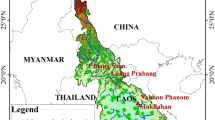Abstract
Aquatic ecosystems are threatened by increasing variability in the hydrologic responses. In particular, the health of river ecosystems in steeply sloping watersheds is aggravated due to soil erosion and stream depletion during dry periods. This study suggested and assessed a method to improve the adaptation ability of a river system in a steep watershed. For this, this study calibrated soil and water assessment tool (SWAT) for runoff and sediment, and quantified the changes in hydrologic responses such as groundwater recharge rate soil erosion and baseflow according to two scenarios for adjustment of the watershed slope (steep to mild). Here, one scenario was set by three measured slopes, and the other was set by fixing the entire watershed slopes with 5 %. Moreover, SWAT and web-based hydrograph analysis tool (WHAT) models were applied to estimate groundwater recharge, soil erosion, and baseflow in the Haean-myeon watershed in South Korea. The results show that the reduction of watershed slope increased groundwater recharge and baseflow, and decreased sediment. Specifically, groundwater recharge rate was increased from 257.10 to 364.60 mm, baseflow was increased from 0.86 to 1.19 m3/s, and sediment was decreased from 194.6 to 58.1 kg/km2. Based on these results, the suggested method will positively contribute to aquatic ecosystems and farming environments in a steeply sloping watershed due to improvements in the quantity and quality of river water.










Similar content being viewed by others
References
Adnan NA, Atkinson PM (2011) Exploring the impact of climate and land use changes on streamflow trends in a monsoon catchment. Int J Climatol 31(6):815–831
Ali G, Tetzlaff D, Soulsby C, McDonnell JJ (2012) Topographic, pedologic and climatic interactions influencing streamflow generation at multiple catchment scales. Hydrol Process 26(25):3858–3874
Allen MR, Ingram WJ (2002) Constraints on future changes in climate and the hydrologic cycle. J Nat 419(6903):224–232
Arnold JG (1992) Spatial scale variability in model development and parameterization. PhD dissertation, Purdue University, West Lafayette, pp 1–186
Arnold JG, Allen PM (1999) Validation of automated methods for estimating baseflow and groundwater recharge from stream flow records. J Am Water Resour Assoc 35(2):411–424
Arnold JG, Srubuvasan R, Muttiah R, Muttiah RS, Williams JR (1998) Large area hydrologic modeling and assessment: part I: model development. J Am Water Resour Assoc 34(1):73–89
Arnold JG, Muttiah RS, Srinivasan R, Allen PM (2000) Regional estimation of baseflow and groundwater recharge in the upper Mississippi river basin. J Hydrol 227(2000):21–40
Bartsch S, Shope C, Arnhold S, Jeong JJ, Park JH, Eum JS, Kim BC, Peiffer SF, Fleckenstein JH (2013) Monsoonal-type climate or land-use management: understanding their role in the mobilization of nitrate and DOC in a mountainous catchment. J Hydrol 507(12):1–16
Bieger K, Hörmann G, Fohrer N (2014) Simulation of streamflow and sediment with the soil and water assessment tool in a data scarce catchment in the three Gorges region, China. J Environ Qual 43(1):37–45
Brooks KN, Ffolliott PF, Magner JA (2012) Hydrology and the management of watersheds. Wiley, Iowa
Brouyre S, Carabin G, Dassargues A (2004) Climate change impacts on groundwater resources: modeled deficits in a chalky aquifer, Geer basin, Belgium. J Hydrol 12:123–134
Busteed PR, Storm DE, White MJ, Stoodley SH (2009) Using SWAT to target critical source sediment and phosphorus areas in the Wister Lake basin, USA. Am J Environ Sci 5(2):156–163
Chaubey I, Cotter AS, Costello TA, Soerens TS (2005) Effect of DEM data resolution on SWAT output uncertainty. J Hydrol Process 19(3):621–628
Daniel JA, Staricka JA (2000) Frozen soil impact on ground water–surface water interaction. J Am Water Resour Assoc 36(1):151–160
Eckhardt K (2005) How to construct recursive digital filters for baseflow separation. J Hydrol Process 19(2):507–515
Eckhardt K (2008) A comparison of base flow indices, which were calculated with seven different base flow separation method. J Hydrol 352:168–173
El Kateb H, Zhang H, Zhang P, Mosandl R (2013) Soil erosion and surface runoff on different vegetation covers and slope gradients: a field experiment in Southern Shaanxi Province, China. Catena 105:1–10
Ficklin DL, Stewart IT, Maurer EP (2013) Effects of projected climate change on the hydrology in the Mono Lake Basin, California. J Clim Change 116(1):111–131
Flanagan DC, Livingston SJ (1995) USDA-water erosion prediction project user summary. NSERL Rep. No. 11, National Soil Erosion Research Laboratory, USDA ARS, West Lafayette, p 139
Ghaffari G, Keesstra S, Ghodousi J, Ahmadi H (2010) SWAT-simulated hydrological impact of land-use change in the Zanjanrood basin, Northwest Iran. J Hydrol Process 24(7):892–903
Guse B, Reusser DE, Fohrer N (2014) How to improve the representation of hydrological processes in SWAT for a lowland catchment—temporal analysis of parameter sensitivity and model performance. Hydrol Process 28(4):2651–2670
He M, Hogue TS (2012) Integrating hydrologic modeling and land use projections for evaluation of hydrologic response and regional water supply impacts in semi-arid environments. Environ Earth Sci 65(6):1671–1685
Heo SG, Kim NW, Park YS, Kim JG, Kim SJ, Ahn JH, Kim KS, Lim KJ (2008) Evaluation of effects on SWAT simulated hydrology and sediment behaviors of SWAT watershed delineation using SWAT ArcView GIS extension patch. J Korean Soc Water Environ 24(2):147–155
Jyrkama MI, Sykes JF (2007) The impact of climate change on spatially varying groundwater recharge in the Grand River watershed (Ontario). J Hydrol 338(3):237–250
Kim JG, Park Y, Yoo D, Kim NW, Engel BA, Kim SJ, Kim KS, Lim KJ (2009) Development of a SWAT patch for better estimation of sediment yield in steep sloping watersheds. JAWRA J Am Water Resour Assoc 45(4):963–972
Kim HW, Sin YJ, Choi JH, Kang HW, Ryu JC, Lim KJ (2011) Estimation of CN-based infiltration and baseflow for effective watershed management. J Korea Soc Water Environ 27(4):405–412
Koulouri M, Giourga C (2007) Land abandonment and slope gradient as key factors of soil erosion in Mediterranean terraced lands. Catena 69(3):274–281
Lee JW, Eom JS, Kim BC, Jang WS, Ryu JC, Kang HW, Kim KS, Lim KJ (2011) Water quality prediction at Mandae watershed using SWAT and water quality improvement with vegetated filter strip. J Korean Soc Agric Eng 53(1):37–45
Lee JW, Kum DH, Kim BC, Kim YS, Jeong GC, Kim KS, Choi JD, Lim KJ (2013) Study on improvement of calibration/validation of SWAT for spatio-temporal analysis of land uses and rainfall patterns. J Korean Soc Water Environ 29(3):365–376
Li Z, Liu WZ, Zhang XC, Zheng FL (2009) Impacts of land use change and climate variability on hydrology in an agricultural catchment on the Loess Plateau of China. J Hydrol 377(1):35–42
Lim KJ, Choi JD, Kim KS, Sagong M, Engel BA (2003) Development of sediment assessment tool for effective erosion control (SATEEC) in small scale watershed. J Korean Soc Agric Eng 45(5):85–96
Lim KJ, Engel BA, Tang Z, Choi J, Kim K, Muthukrishnan S, Tripathy D (2005) Automated web GIS-based hydrograph analysis tool, WHAT. J Am Water Resour Assoc 41(6):1407–1416
Luo Y, Arnold J, Allen P, Chen X (2012) Baseflow simulation using SWAT model in an inland river basin in Tianshan Mountains, Northwest China. Hydrol Earth Syst Sci 16(4):1259–1267
Lyne VD, Hollick M (1979) Stochastic time-variable rainfall-runoff modeling. Hydrology and water resource symposium. Institution of Engineers Australia, Perth, pp 89–92
McDonald MG, Harbaugh AW (1988) A modular three-dimensional finite-difference ground-water flow model: U.S. geological survey techniques of water-resources investigations book 6, Chap A1, p 586
Nash JE, Sutcliffe JV (1970) River flow forecasting through conceptual models: part I. A discussion of principles. J Hydrol 10(3):282–290
Nathan RJ, McMahon TA (1990) Evaluation of automated techniques for baseflow and recession analysis. J Water Resour 26(7):1465–1473
Park YS, Kim J, Kim N, Kim S, Jeon J, Engel BA, Jang W, Lim KJ (2010) Development of new R, C, and SDR modules for the SATEEC GIS system. Comput Geosci 36(6):726–734
Paul II, Bayode EN (2012) Watershed characteristics and their implication for hydrologic response in the Upper Sokoto Basin, Nigeria. J Geogr Geol 4(2):147–155
Ramanarayanan TS, Williams JR, Dugas WA, Hauck LM, McRarland AMS (1997) Using APEX to identify alternative practices for animal waste management. ASAE international meeting 97-2209
Ryu JC, Choi JW, Kang HW, Kum DH, Shin DS, Lee KH, Jeong GC, Lim KJ (2010) Evaluation of groundwater recharge for land uses at Mandae stream watershed using SWAT HRU mapping module. J Korea Soc Water Environ 28(5):743–753
Santhi C, Arnold JG, Williams JR, Dugas WA, Srinivasan R, Hauck LM (2001) Validation of the SWAT model on a large river basin with point and nonpoint sources. JAWRA J Am Water Resour Assoc 37(5):1169–1188
Schroeder PR, Aziz NM, Lloyd CM, Zappi PA (1994) The hydrologic evaluation of landfill performance (HELP) model. User’s guide for version 3. EPA/600/R-94/168a, US Environmental Protection Agency, Cincinnati
Shope CS, Maharjan GR, Tenhunen J, Seo B, Kim K, Riley J, Arnhold S, Koellner T, Ok YS, Peiffer S, Kim B, Park JH, Huwe B (2013) An interdisciplinary SWAT ecohydrological model to define catchment-scale hydrologic partitioning. Hydrol Earth Syst Sci 10:7235–7290
Skaggs RW (1982) Field evaluation of a water management simulation model. Trans ASAE 25(3):666–674
TERRECO http://www.bayceer.uni-bayreuth.de/terreco/index.php?lang=en
Van Liew MW, Arnold JG, Garbrecht JD (2003) Hydrologic simulation on agricultural watersheds: choosing between two models. Trans ASAE 46(6):1539–1551
Wei W, Chen LD, Fu BJ, Huang ZL, Wu DP, Gui LD (2007) The effect of land uses and rainfall regimes on runoff and soil erosion in the semi-arid loess hilly area, China. J Hydrol 335:247–258
Wu W, Clark JS, Vose JM (2014) Response of hydrology to climate change in the southern Appalachian Mountains using Bayesian inference. J Hydrol Process 28(4):1616–1626
Yan B, Fang NF, Zhang PC, Shi ZH (2013) Impacts of land use change on watershed streamflow and sediment yield: an assessment using hydrologic modelling and partial least squares regression. J Hydrol 484:26–37
Yoo DS, Kim KS, Jang WS, Jun MS, Yang JE, Kim SC, Ahn JH, Lim KJ (2008) Evaluation of sediment yield using area-weighted measured slope and slope length at Haean myeon watershed. J Korean Soc Water Environ 24(5):569–580
Zhang B, Yang YS, Zepp H (2004) Effect of vegetation restoration on soil and water erosion and nutrient losses of a severely eroded clayey plinthudult in southeastern China. Catena 57:77–90
Zhang X, Srinivasan R, Hao F (2007) Predicting hydrologic response to climate change in the LUOHE river basin using the SWAT model. Am Soc Agric Biol Eng 50(3):901–910
Acknowledgments
This research was supported by the Eco-Star Project (No: EW32-07-10) in Korea.
Author information
Authors and Affiliations
Corresponding author
Rights and permissions
About this article
Cite this article
Lee, J.M., Park, Y.S., Kum, D. et al. Assessing the effect of watershed slopes on recharge/baseflow and soil erosion. Paddy Water Environ 12 (Suppl 1), 169–183 (2014). https://doi.org/10.1007/s10333-014-0448-9
Received:
Revised:
Accepted:
Published:
Issue Date:
DOI: https://doi.org/10.1007/s10333-014-0448-9




